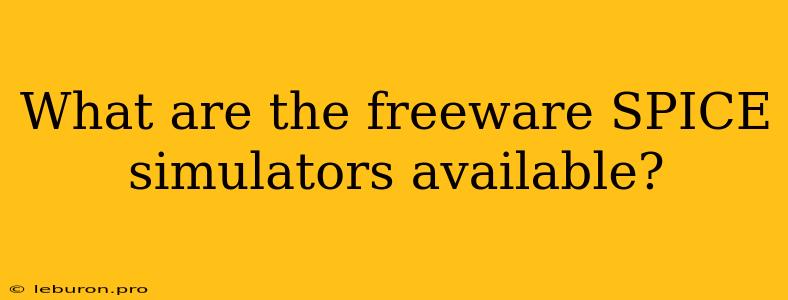Spice, an acronym for Simulation Program with Integrated Circuit Emphasis, is a widely used electronic circuit simulator program. It allows engineers and designers to simulate the behavior of electronic circuits without the need for physical prototyping, which is often expensive and time-consuming. Spice simulations are crucial in the design process for validating circuit concepts, analyzing performance, and optimizing designs. While there are commercial Spice simulators available, several freeware alternatives offer comparable functionality and are valuable tools for hobbyists, students, and even professional engineers. This article explores the diverse world of freeware Spice simulators, examining their features, advantages, and limitations.
Exploring the Landscape of Freeware SPICE Simulators
The world of freeware SPICE simulators is rich and varied, catering to a diverse range of users and applications. These simulators often differ in their ease of use, simulation capabilities, and the level of customization they offer. Here are some prominent players in the freeware Spice simulator landscape:
1. NGSpice
NGSpice, short for "New Generation Spice," is a highly popular and versatile open-source Spice simulator. It has become a standard in the open-source community, boasting a large user base and a vast collection of libraries and models. NGSpice offers a robust feature set, including:
- Comprehensive SPICE Syntax Support: NGSpice supports the vast majority of SPICE syntax, ensuring compatibility with numerous circuit designs and libraries.
- Advanced Simulation Capabilities: It offers a wide range of simulation types, including transient analysis, AC analysis, DC analysis, and noise analysis.
- Extensive Model Library: NGSpice comes with a comprehensive library of device models, covering a wide range of semiconductor devices, including transistors, diodes, and operational amplifiers.
- Customization Options: NGSpice allows users to extend its functionality through scripting and custom model development.
2. LTspice
LTspice, developed by Analog Devices, is another widely used and powerful freeware Spice simulator. It's particularly popular amongst circuit designers due to its user-friendly graphical interface, comprehensive device library, and integration with the popular LTspice schematic capture tool. Key features of LTspice include:
- Intuitive Graphical Interface: LTspice's interface is designed to be user-friendly, making it easier for beginners to get started with Spice simulations.
- Extensive Device Library: LTspice boasts a vast library of models for various electronic components, including active devices like transistors, passive components like resistors and capacitors, and specialized components like operational amplifiers and voltage regulators.
- Advanced Analysis Features: LTspice provides advanced simulation capabilities, including transient analysis, AC analysis, DC analysis, and noise analysis.
- Interactive Simulation Environment: LTspice allows users to interactively modify circuit parameters and observe the effects on simulation results in real-time.
3. TINA-TI
TINA-TI, developed by Texas Instruments, is a powerful Spice simulator integrated with a schematic capture tool. It's a popular choice for users working with Texas Instruments components, as it features a comprehensive library of models for TI devices. TINA-TI offers a comprehensive feature set, including:
- Built-in Schematic Capture: TINA-TI's integrated schematic capture tool simplifies circuit design and eliminates the need for external schematic editors.
- Extensive Model Library: TINA-TI includes a vast library of device models specifically for Texas Instruments components, simplifying simulations for TI-based designs.
- Advanced Simulation Capabilities: TINA-TI supports various simulation types, including transient analysis, AC analysis, DC analysis, and noise analysis.
- Interactive Simulation Environment: TINA-TI allows users to interactively modify circuit parameters and observe the effects on simulation results in real-time.
4. KiCad
KiCad is a comprehensive open-source electronics design suite that includes a freeware Spice simulator called Spice-Sim. While KiCad primarily focuses on PCB design, the integrated Spice-Sim provides a functional simulation tool for circuit analysis. Key features of Spice-Sim include:
- Integration with KiCad: Spice-Sim is seamlessly integrated within KiCad, allowing users to simulate circuits designed within the KiCad environment.
- Basic SPICE Functionality: Spice-Sim provides basic SPICE functionality for transient analysis, AC analysis, and DC analysis.
- Open-Source Nature: Spice-Sim's open-source nature allows for community contributions and customization.
5. Xyce
Xyce is a high-performance open-source SPICE simulator that focuses on parallel processing and large-scale simulations. It's particularly well-suited for complex circuit simulations that demand significant computational resources. Key features of Xyce include:
- High Performance: Xyce leverages parallel processing to accelerate simulations, making it suitable for large and complex circuits.
- Advanced Features: Xyce offers advanced features like sensitivity analysis, Monte Carlo analysis, and distributed simulation.
- Extensibility: Xyce's open-source nature allows for extensions and custom model development.
Choosing the Right Freeware SPICE Simulator
The best freeware Spice simulator for a particular application depends on individual needs and priorities. Consider these factors when making a selection:
- User Interface: Some simulators have more user-friendly interfaces than others, making them easier for beginners to learn and use.
- Simulation Capabilities: The types of analysis and simulations offered by each simulator should align with the specific requirements of your project.
- Device Library: The availability of device models for the specific components used in your circuit is crucial for accurate simulation.
- Community Support: A large and active community around a simulator can be beneficial for finding help, troubleshooting issues, and sharing knowledge.
Limitations of Freeware SPICE Simulators
While freeware Spice simulators offer excellent value, they may have limitations compared to commercial versions:
- Limited Support: Freeware simulators may have fewer support options compared to their commercial counterparts.
- Fewer Advanced Features: Some advanced features, such as mixed-signal simulation and electromagnetic analysis, might be absent in freeware versions.
- Limited Customization: Freeware simulators might have more limited customization options compared to commercial versions.
Conclusion
Freeware Spice simulators provide a powerful and accessible tool for circuit simulation, making them invaluable for hobbyists, students, and even professional engineers. Each simulator offers unique strengths, and choosing the right one depends on your specific needs and project requirements. While freeware simulators may have some limitations compared to commercial alternatives, they remain excellent choices for a wide range of applications, especially for those seeking cost-effective and efficient circuit analysis solutions.
